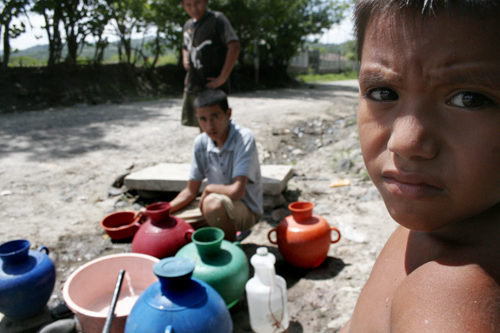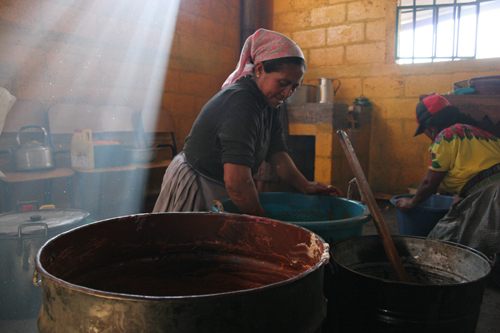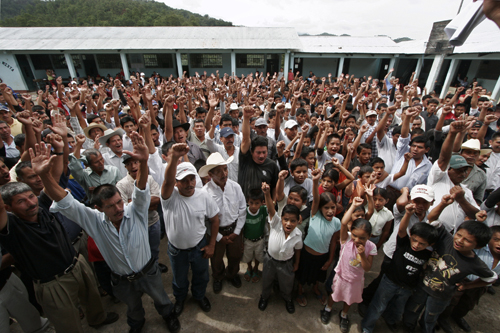2012 AI Canada Exhibit: Canadian Metal Mining in Central America: Development or Myth?
Amnesty International Canada proudly presents Canadian Metal Mining in Central America: Development or Myth?, a new photo exhibit by documentary photographer James Rodriguez that engages viewers to consider essential questions about Canada’s self-proclaimed role of responsible global leader in mining development.
 As one of the largest worldwide players in the extractive industries sector, Canada boasts over $79 billion of direct investment abroad, while Canadian mining companies account for 43% of global mineral exploitation costs. Most mineral-rich countries are found in the Developing Global South and lack the expertise and economic resources to extract these high priced commodities at industrial levels. Such limitations have prompted Canadian-based companies, with support from the Canadian government, to step in. Latin America has especially provided fertile ground for Canadian-run mining projects that have sprouted over the past decade or so. This period has coincided with an unprecedented rise in prices for precious metals. Gold, for example, has risen from US $273 per troy ounce in 2000 to a still-climbing US $1,908 per troy ounce as of August 2012.
As one of the largest worldwide players in the extractive industries sector, Canada boasts over $79 billion of direct investment abroad, while Canadian mining companies account for 43% of global mineral exploitation costs. Most mineral-rich countries are found in the Developing Global South and lack the expertise and economic resources to extract these high priced commodities at industrial levels. Such limitations have prompted Canadian-based companies, with support from the Canadian government, to step in. Latin America has especially provided fertile ground for Canadian-run mining projects that have sprouted over the past decade or so. This period has coincided with an unprecedented rise in prices for precious metals. Gold, for example, has risen from US $273 per troy ounce in 2000 to a still-climbing US $1,908 per troy ounce as of August 2012.
Canadian embassies and trade commissions have aggressively promoted the mining industry’s agenda on foreign soil, while large-scale public media campaigns, both at home and abroad, promote corporate social responsibility practices. Canada’s Prime Minister Stephen Harper’s support for the mining industry has gone as far as outspokenly accusing those opposed to mining as being “in favour of keeping people poor” in developing countries.
 But Canadians must ask ourselves: have Canadian-run mining projects truly brought economic and social advancement to impoverished communities in Latin America? Or has mining provided unprecedented cash flow for very few in the North, while causing massive environmental degradation and health issues, promoting social conflicts, feeding corruption and even spawning brutal violence in the Global South? Communities from Argentina to Mexico seem to argue the latter.
But Canadians must ask ourselves: have Canadian-run mining projects truly brought economic and social advancement to impoverished communities in Latin America? Or has mining provided unprecedented cash flow for very few in the North, while causing massive environmental degradation and health issues, promoting social conflicts, feeding corruption and even spawning brutal violence in the Global South? Communities from Argentina to Mexico seem to argue the latter.
Based in Guatemala since 2004, documentary photographer James Rodriguez presents an unequivocal visual registry of the impact Canadian mining industries have had on rural communities in Mexico, Central America and the Dominican Republic.
Canadian Metal Mining in Central America: Development or Myth? aims to bring home the debate regarding the perceived benefits of the Canadian government’s support for an unregulated overseas mining sector by presenting first-hand the stories and voices of those affected by Canadian policies and investment. These stories of everyday-people-turned-human-rights-defenders, most of them Indigenous men and women of Mesoamerica, will undoubtedly provide the Canadian public with the so-far untold story about this highly-criticized Canadian economic development model.
 Amnesty International is a worldwide human rights organization with 2.2 million members and subscribers in more than a 150 countries and regions. Independent of all governments and ideologies, Amnesty International was awarded the 1977 Nobel Peace Prize for its efforts to promote global observance of the Universal Declaration of Human Rights.
Amnesty International is a worldwide human rights organization with 2.2 million members and subscribers in more than a 150 countries and regions. Independent of all governments and ideologies, Amnesty International was awarded the 1977 Nobel Peace Prize for its efforts to promote global observance of the Universal Declaration of Human Rights.
James Rodriguez is a US-Mexican independent documentary photographer and photojournalist focused on exposing and documenting social justice issues, particularly those involving land tenure, human rights abuses, post-war processes, and negative effects of globalization. For more information, please visit mimundo.org.
This exhibit Canadian Metal Mining in Central America: Development or Myth? will be shown across Canada through fall and winter 2012/13. For booking or other information, please contact exhibit coordinator Eduardo Velez at bhr@amnesty.ca
